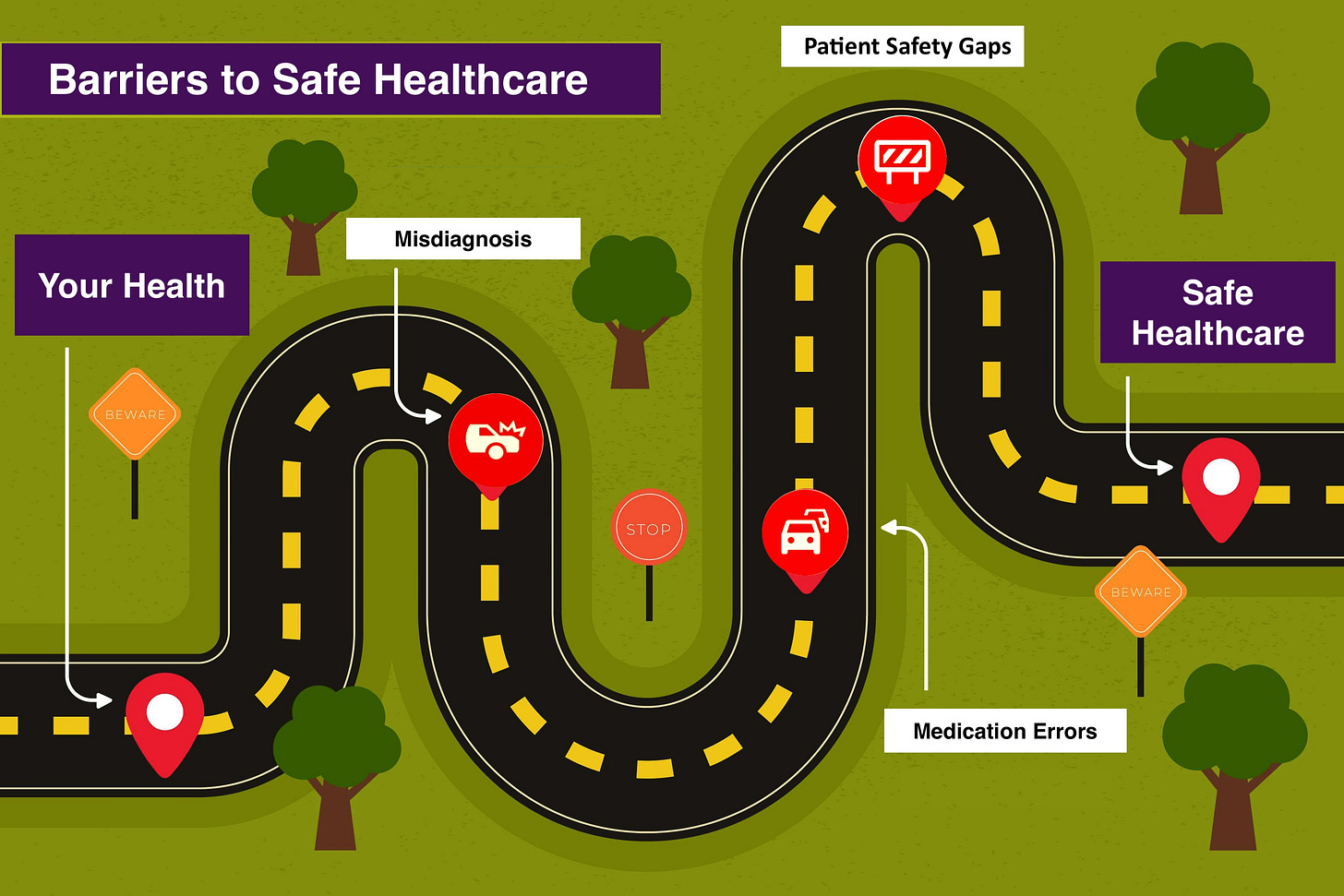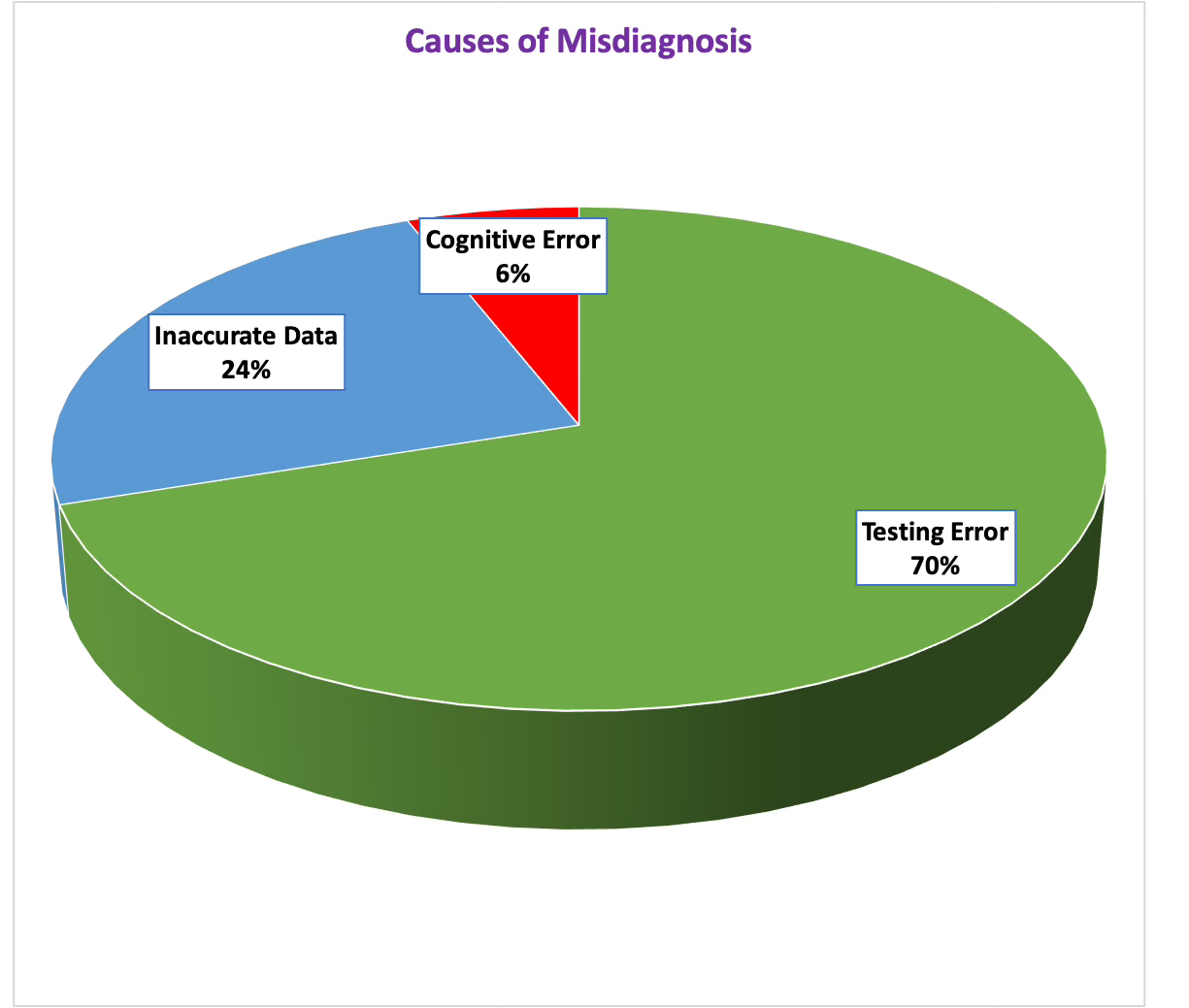Chapter 1: How Bad is the American Healthcare System, Really?
It Helps to Know What To Watch Out For
You can’t protect yourself if you don’t know where the accidents, construction, and stalled cars are on the road to the quality healthcare you want and need. Falling through the large cracks of our medical system is far worse than being late because of traffic. So here’s your road map.
If the information below feels overwhelming today, don’t worry. This chapter will remain available, so just bookmark it and use it like a reference document as you interact with healthcare. I promise, I’ll dive deeply into each of these errors and harms one-by-one over the next year and share what you can do to protect yourself. By the way, if a medical term is unfamiliar to you, right-click on the word and choose “Look up.” Or ask in the comments below.
The Top-Line. Everyone complains about healthcare in America. It’s expensive, we often have to wait a long time to be seen, and then we don’t get a lot of time with our doctors. Compared with other developed countries, we spend the most, we die the youngest, and our health metrics are the worst. And it’s not expected to improve soon. Our life expectancy was ranked 49th in 2022 and is expected to rank 66th in 2050!
Yes, some of this is lifestyle. Which is a nice way of saying it’s partly our own fault. We’re overweight, we drink too much, we have high drug addiction rates, and we don’t exercise enough. I’ve broken enough New Year’s resolutions to recognize I’m part of the problem, too.
U.S. healthcare is filled with errors of every kind. But most of this is due to how complex the process is. From the moment you walk in the door of a healthcare site, there are thousands of little steps that need to go right. Not every error leads to harm but the more we can prevent, the better. There are three major types of medical harm:
1. Diagnosis Errors (identifying the cause of your symptoms)
2. Medication errors
3. Patient Safety gaps
Source: ECRI 2024
Diagnosis Errors
The Top-Line: Misdiagnosis is common. If the diagnosis is wrong, all the treatment in the world won’t help you in the long run. Every year, 50 to over 100 million diagnostic errors occur. That includes being told the wrong cause for your symptoms, dismissed with no diagnosis, or not told your diagnosis, a major communication error. Every American will likely deal with at least one misdiagnosis in their lifetime and one third of us will be harmed by it. My son was misdiagnosed over 15 times before his 15th birthday from just four separate common issues. The last one nearly killed him.
The Scariest Number: Almost 800 thousand adults die or are horribly harmed by misdiagnosis, including no diagnosis, every year. For that second metric, significant harm, we’re talking about the types of errors in diagnosis that result in becoming disabled, losing a limb or an organ. And new studies say that number is underestimated.
The Number One Cause is Testing Errors: We tend to blame the human with the medical degree and call it medical gaslighting. But, 70% of diagnostic mistakes are due to something going awry in the testing process, resulting in inaccurate tests. Errors can happen at every step, from ordering, collecting, processing, obtaining results, or communicating results. It can affect every kind of medical test: blood, urine, imaging and more.
Technical or processing problems are responsible for 23% of these testing errors. I recently went to a local lab for five different blood tests. They ran or reported only two of them and I’ll never know how that happened.
Identity errors cause another 20 percent, like mixed-up samples, mislabeled specimens, and tests performed on the wrong patient. I just heard from a patient whose imaging tests reported her gallbladder was fine but her gallbladder had been removed years before. Was that an identity error or did the radiologist misread the film?
Dropping the ball happens at the lab or the doctor’s office. One of every eight tests get lost in the system. Plus 9% of the time the doctor reviewing the results to determine next steps fails to follow-up fully. One reason why my son nearly died at 15 is that his pediatrician didn’t understand how to read the tests she ordered for him eight years in a row, so she insisted he didn’t have the medical condition we suspected. He did.
And, Yes, the Human Factor in Testing. The rest may be due to the doctor making one or more of the following types of errors: choosing the wrong test, omitting the right test, misunderstanding the test results or being too dependent on tests and ignoring what they can observe clinically, You can be seriously ill despite all your test results being reported as fine, if the doctor chooses the wrong tests.
Errors Also Happen in the Doctor’s Office and in the Doctor’s Brain. A physician needs complete data to make an accurate diagnosis. The intake forms, the patient’s history and the physical exam are essential to get right. Errors often happen if:
the doctor doesn’t get your full history because he’s distracted, rushed, or thinks he knows what it is before you finish talking. The average patient is interrupted by the doctor in just 11 seconds.
he doesn’t physically examine you fully, or at all. I was misdiagnosed three times in one visit because the internist never did a physical exam.
the assistant messes up typing up the form you filled out in the waiting room. Here’s one reason you should fill out those forms online before your appointment if the option is offered.
Or if you omit something essential.
Wow! 188 Types of Cognitive Errors in One Infographic Are Too Many to See Here
Doctors can make bone-headed mistakes but not as often as we think they do. Just 3 to 9% of the time a doctor has ALL the info needed to make the correct diagnosis and doesn’t. Known as Cognitive Errors or Biases, doctors can misdiagnose due to bad judgment; cultural or racial biases; personal issues like their own health; training gaps; lack of experience; overconfidence; or simply due to a lack of imagination, There are 188 different types of cognitive biases and everyone in the world is affected by them. It’s part of the human condition. Here’s a real life example of Anchoring Bias: A visibly overweight patient gets sent home with an exercise and diet plan while his colon cancer is missed because the physician’s decision-making capability is anchored –– stuck –– in the dangers of too much weight.
Medication Errors
Yes, even with an accurate diagnosis, getting the wrong medicine is common. This issue crosses professional boundaries, with diagnosticians, pharmacists, nurses and more cited as a source of the problem. Depending on the study design, 23 to 92 percent of the medicines you take at home are not exactly the right choice or taken the proper way. Prescribing errors were the most common error. The number one reason identified is inadequate training across all medical professionals. That includes ordering the wrong drug; the wrong dose; not explaining the instructions correctly; missing known allergic reactions; or mixing two medications that should never be taken together. I once picked up my birth control pills and got someone else’s cardiac medicine. I’m not certain what he did with my birth control pills.
Patient Safety Gaps in Hospitals and Nursing Homes
The Top-Line: Despite claims that improving Patient Safety is a priority for hospital administrators, it just as bad today as it was when it was first measured over 25 years ago.
By the Numbers: One-fourth of patients in America admitted to a hospital (9 million) or a nursing home (400 thousand) are harmed every year by medical error, from misdiagnosis to surgical error to medication error. A new study by Harvard University found that 38% of surgical patients had at least one adverse event, meaning the harm was caused by medical mismanagement, not the original illness. Over 40% of those issues were deemed serious or life-threatening.
Most errors causing patient harm were preventable. Surgical complications, medication errors, and healthcare-associated infections were the most common problems. My mother lived to the ripe old age of 95 but she died when the emergency doctors delayed giving her the IV antibiotics her wound care doctor ordered, for more than 24 hours.
Now you know where the dangers lie. There are things we can do as patients to protect ourselves and our loved ones. We’ll address them one-by-one over the next 11 months. Meanwhile, take a look here at the chapters to come and start sharing your questions now.
Next up, Chapter 2. The Very First Thing You Should Do Today
© Helene M. Epstein, 2025









Helene, thank you for publishing this important book and making it free for all to read. Your first chapter is right on the money and I can't wait to read the next one
This is a remarkably valuable piece, as disturbing as it is crucial to understand and save for reference. Thank you, Helene.